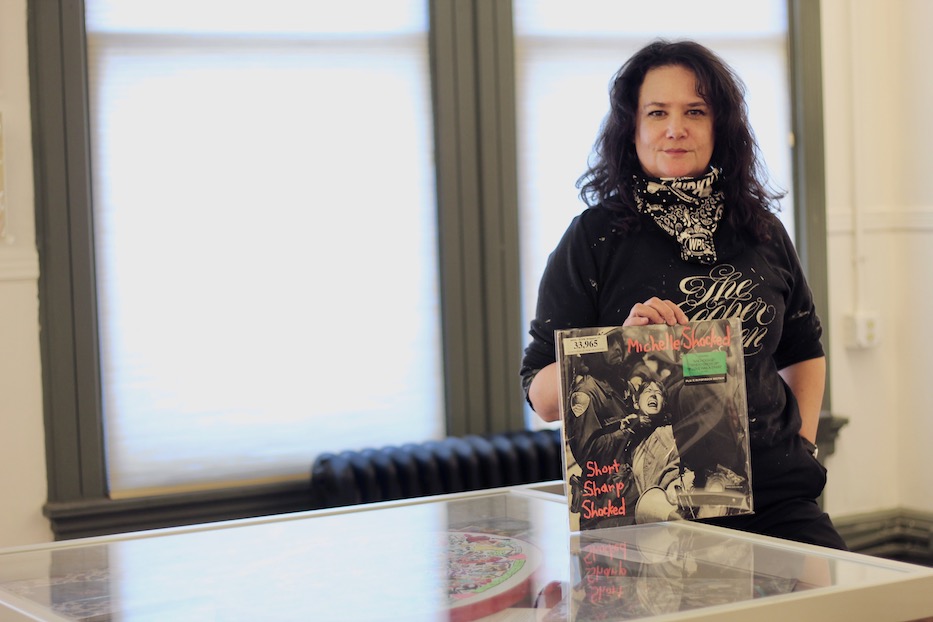
Culture & Community | Downtown | Institute Library | Arts & Culture | Ninth Square
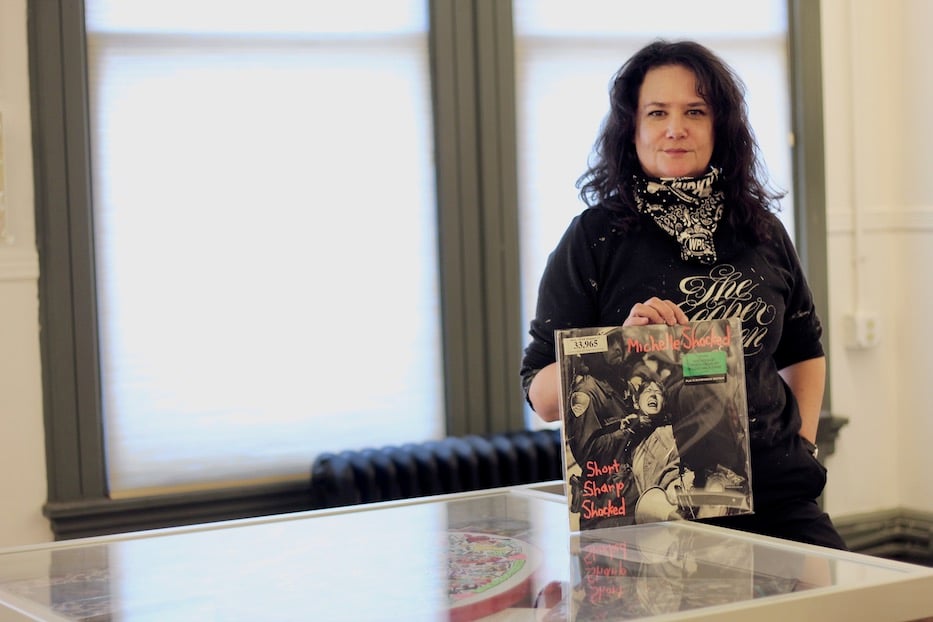
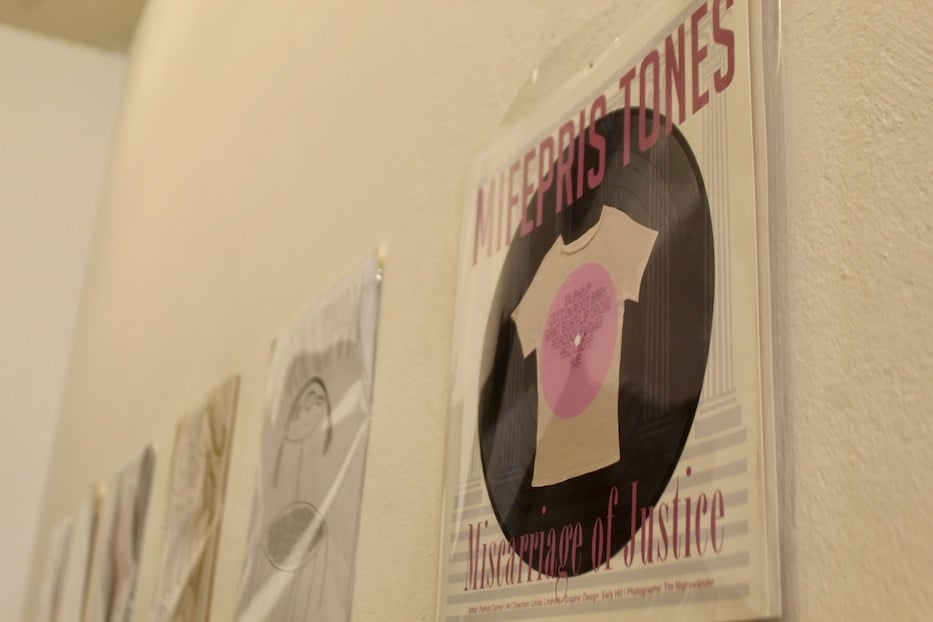
Top: Curator Martha Lewis. Bottom: Patrick Carroll, Linda Lindroth, Sally Hill, Tim Nighswander, Miscarriage of Justice. Lucy Gellman Photos. Sound & Vision II: For The Record runs through May 6 at the Institute Library, 847 Chapel St. in downtown New Haven.
The record cover comes alive from where it hangs on the wall, announcing itself in a geometric mash up of color. A perfect, carnation-pink circle blooms in the center of a white t-shirt, names scrawled across its torso. They seem like botanically rad song titles: “Silphium,” “Giant Boat Lip Orchid,” “Peacock Flower,” “Rue.” Six doric columns rise around them.
But the longer a viewer looks, the more a different reality sets in: these are natural abortifacients, used for centuries before emergency contraception or medicated abortion were ever an option. Will they be finding use again, in this post-Roe world? The title Miscarriage of Justice scrawls across the bottom, just one shade short of oxblood.
The fictitious album, from the equally fictitious Mifepris Tones, is part of Sound & Vision II: For The Record, running in the Gallery Upstairs at The Institute Library through May 6. Curated by artist Martha Lewis with over two dozen participating artists, the group show uses sharp, funny, and almost entirely made up album art to speak truth to power.
It is a collaboration with Cafe Nine and the Bridgeport-based radio station WPKN, where Lewis has hosted “Live Culture” for the better part of a decade. And as it comes to the IL, it reads as both a celebration of women and music and a reminder that people must hold onto their ability to play, even as the world turns on its head.
“This is unlike any other show I’ve done before in that it is coming together organically,” Lewis said on a recent Thursday, as she studied a photo of the musician Julia Cumming. “This is about having something fun [album covers] attached to something serious [Women’s History Month]. The best thing I could think of is to make people not want to turn away from it. This is the only way we’re gonna survive all of the crazy that is surrounding us.”
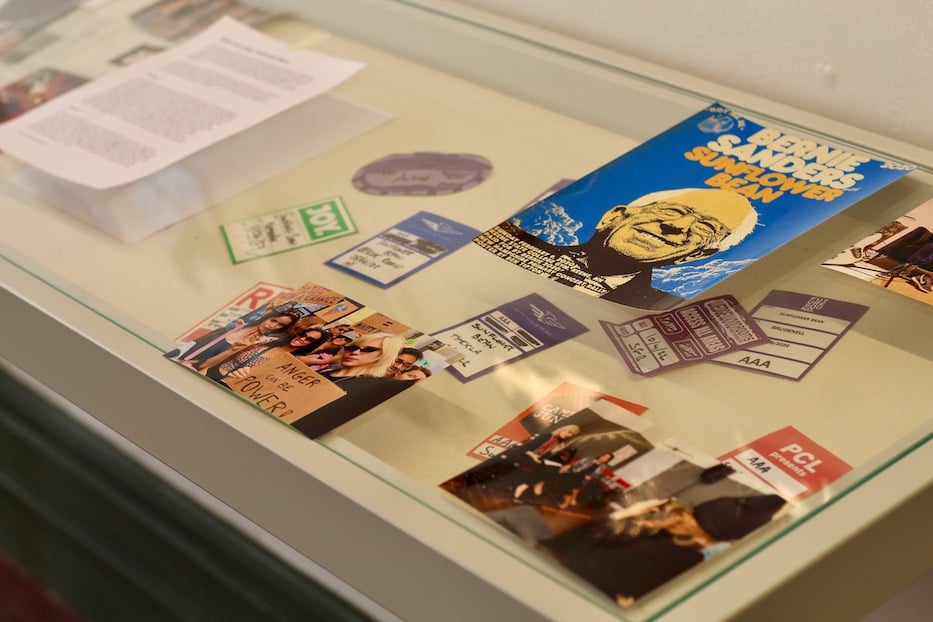
Part of a case dedicated to Julia Cumming, of the band Sunflower Bean.
The idea for the exhibition began in multiple places, from Lewis’ love for music and artmaking to the fall of Roe v. Wade last June to her belief in laughter as a kind of medicine. Eight years ago this fall, she hosted the first Sound & Vision at the Institute Library during City-Wide Open Studios, in part as a benefit for WPKN. That show featured imaginary album covers, with titles that ranged from hyper-local nods to New Haven to the inspiration artists, many of them musicians, found in nature.
The show was a hit: dozens of people came out to a Halloween-night silent auction, rocking their costumes as they bounced from artwork to artwork. She loved how much the show relied on imagination, and how much joy participating artists and supporters took in simply attending together. In the years since, particularly as Covid has changed how and when people gather, she’s missed the buzzing, palpable energy that comes with a good opening.
So when she started thinking about a show that would fit Women’s History Month—in a world that had completely transformed since that first show—the same format sprang to mind.
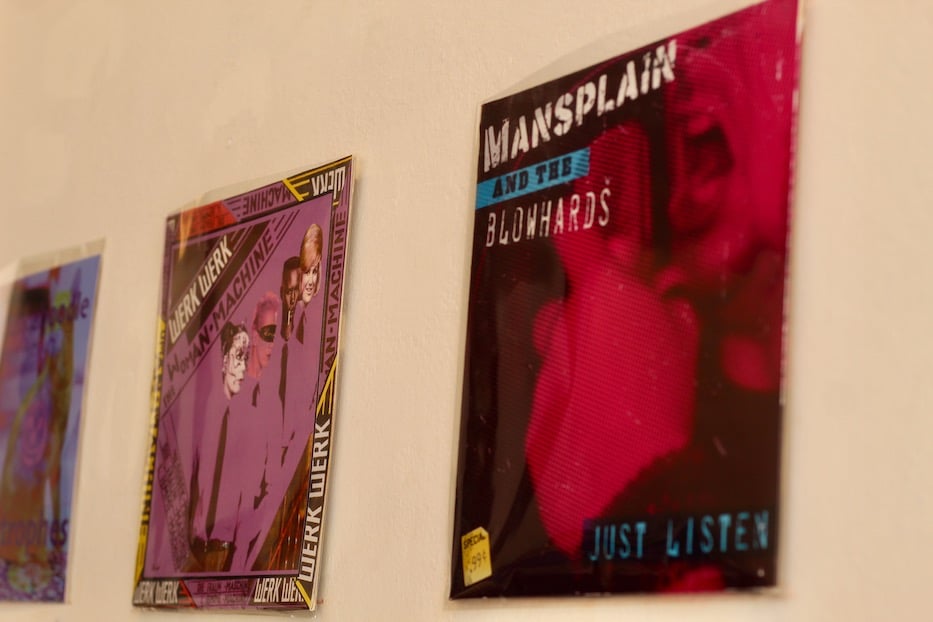
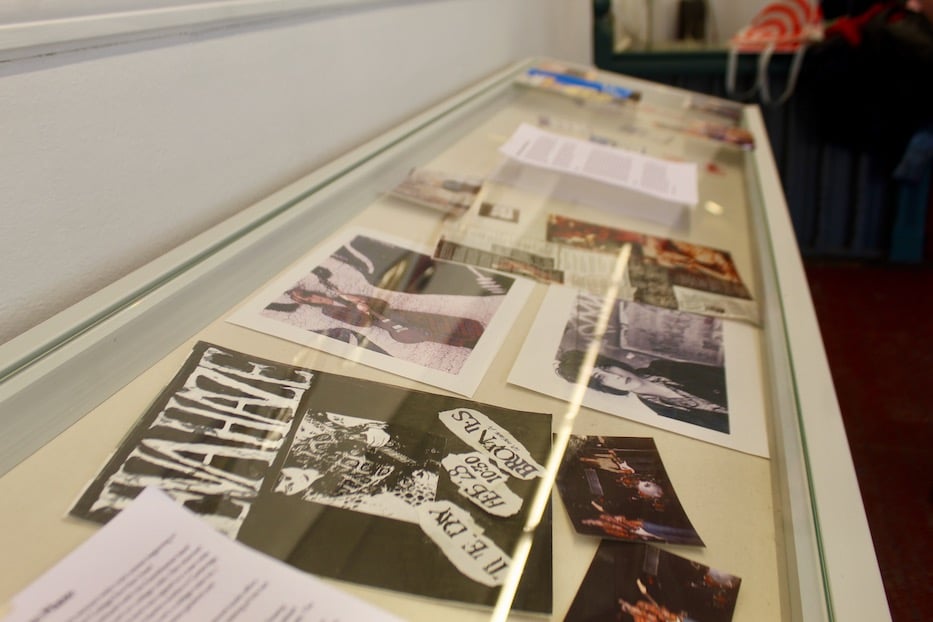
Top: Emily Heberich, "The Woman Machine," WERK WERK and George Corsillo, "Mansplain & The Blowhards" Just Listen. Bottom: Eve Hars of Eva Haze.
She put out an open call for artists with minimal requirements: pieces had to be 12 x 12 inches, but any medium was fine. They had to celebrate women in music, whatever form that took. The rest was up to the artists. Around three dozen submissions rolled in.
“Redo your favorite artist’s best record, invent your own girl-group, create a diva and her playlist, imagine a musical tribute to a favorite historic S/hero,” she wrote at the time. “The sky is the limit.”
The results, which both wrap around the room and beckon from several glass-covered cases, respond with everything from deeply felt high art and to straight-up sass, sometimes delivered with glitter. Not far from the entrance, Claudia Dorin’s oil-on-canvas Kiss draws a viewer in, with two interlocking faces that are minimal, Matissian outlines of themselves. Dorin’s sense of movement and line is easy, and it’s worth getting lost in a little.
Others have teeth, and a viewer is luckier for it. In Ann Kennedy’s take on Lesley Gore’s You Don’t Own Me, she goes right for the Supreme Court. Instead of Gore’s bright-eyed, wholesome, strawberry blonde original cover—released 10 years before the court voted on Roe v. Wade the first time—this one shows a portrait of the current court, with their faces roughly scratched out.
To their left, a messy cutout collage spells out “Lesley Gore and Friends,” as if it’s a ransom note. It gives the song a new-old kind of meaning.
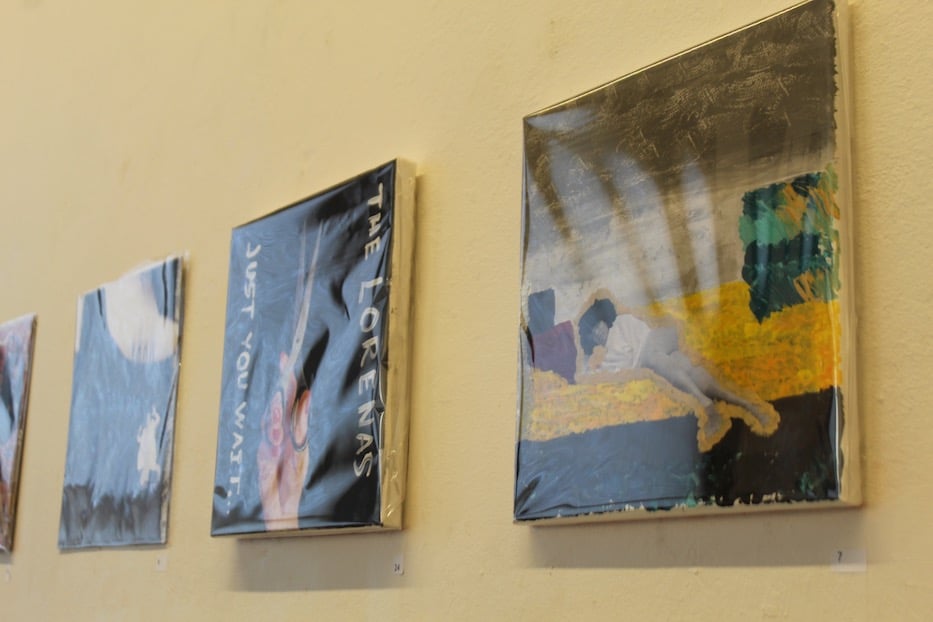
John Keefer, The Lorenas, Just You Wait and T.M. Stewart, Love, Love.
Lewis is right to use the word fun: the covers are endlessly entertaining to look at, and warrant at least two trips to this gem of a room on Chapel Street, Some artists, including T.M. Stewart and John Keefer, have submitted thick, hefty canvases that are still within the size limit, demanding that a viewer come in close to study them. Others, like Corinthia Saez, have come up with designs that are transportive, or reimagine albums that have become part of who an artist is.
Even Lewis has gotten in on the idea. Close to the entrance, a cover from the artist offers the title Lean In, a riff on Sheryl Sandberg’s insufferable book of the same title. In the center of a white-and-green cover, a woman’s pale, neoclassical features have become distorted, as if she is leaning in close to a fun house mirror, or a pool of water and oil. Song titles include “80 Cents on the Dollar,” “My Body, Your Choice,” “Manbaby” and “Talkin’ Over Me Again.”
Lewis’ made-up band, in this case, is fittingly called the “Ladders and Ceilings,” which women are expected to climb and shatter respectively as they lean in so far they’re nearly falling on their faces. The titles, meanwhile, speak for themselves: the U.S. is still a country that can dance itself silly to “Girls Run The World,” but equivocates when it comes to equal pay and basic bodily autonomy. For anyone who has felt tired of feeling tired, Lewis lets them know that they’re doing just fine.
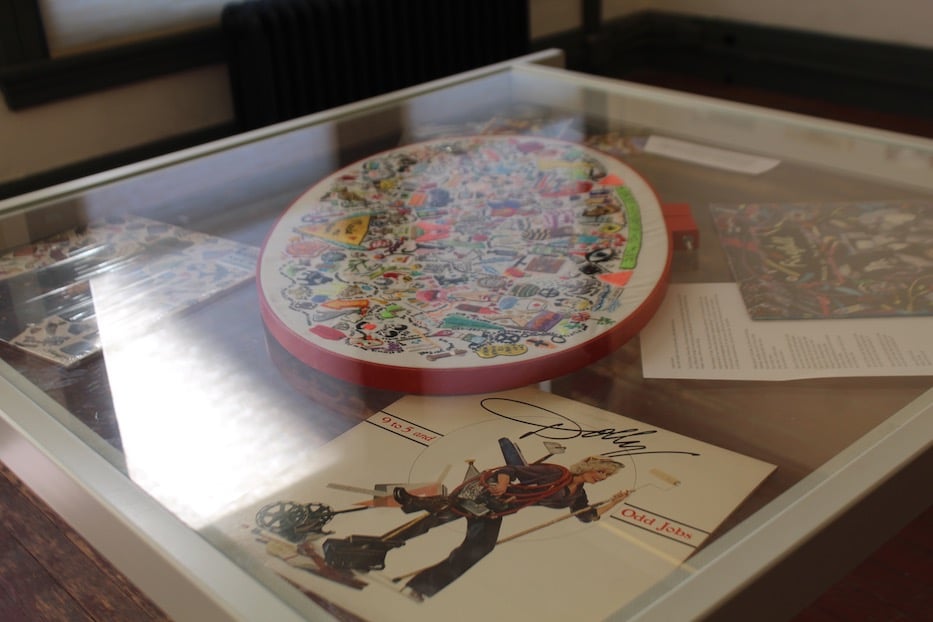
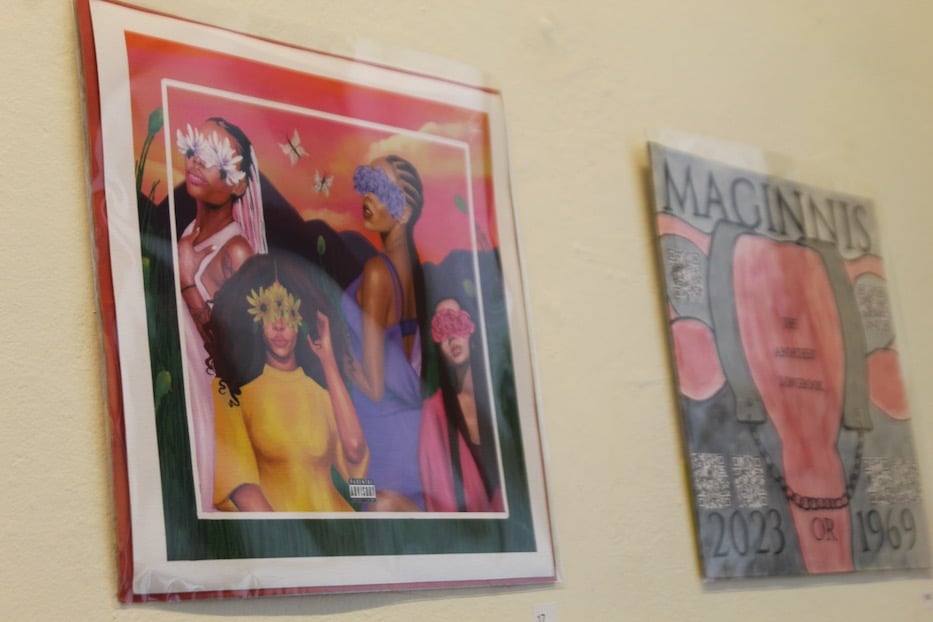
Top: At center of the table: Michelle Beaulieu-Morgan's "A Brief History Of How Music/Made Me Queer." Clockwise, it is surrounded by album covers from George Corsillo (Dolly Parton), Beaulieu-Morgan (Keb' Mo'), Clymenza Hawkins (Erykah Badu) and Linda Lindroth (Firefall).Bottom: Corinthia Saez, Woman of Flowers and Jody Clouse, Maginnis Remembered.
In a testament to the city’s talent, there’s also a nod to album art that has made it on the professional scale, and is now part of the cultural zeitgeist. In 2019, the Grammy-winning blues musician Keb' Mo' used original artwork from New Haven’s Michelle Beaulieu-Morgan for his studio album Oklahoma. Two decades before that, Bridgeport-based artist Clymenza Hawkins, who may be best known for her otherworldly collages, landed the commission for the cover of Erykah Badu’s 1997 Live recording.
From artist and longtime Institute Library supporter George Corsillo, who now runs the studio Design Monsters with his wife, the artist Susan McCaslin, there’s the cover of 9 to 5 and Odd Jobs, with a vacuum-sporting Dolly Parton looking up at a viewer from beneath the vitrine. Artist Linda Lindroth, a viewer learns, was responsible for birthing Firefall’s Mirror Of The World.
These are reminders of not only how artists support the industry across media, but a way to trace how they got there, and in some cases where they have gone since. They’re also fun: Corsillo has multiple fictitious covers in the show, including Just Listen from Mansplain & The Blowhards. So too Beaulieu-Morgan’s Woe Omen: The Ruining, an embroidered imaginary album cover on the wall.
Back in the case, beside the real album cover, Beaulieu-Morgan has also included a huge, fine-tuned piece of embroidery that reads “A Brief History Of How Music/Made Me Queer.” It inverts the idea of craft while pulling a viewer in.
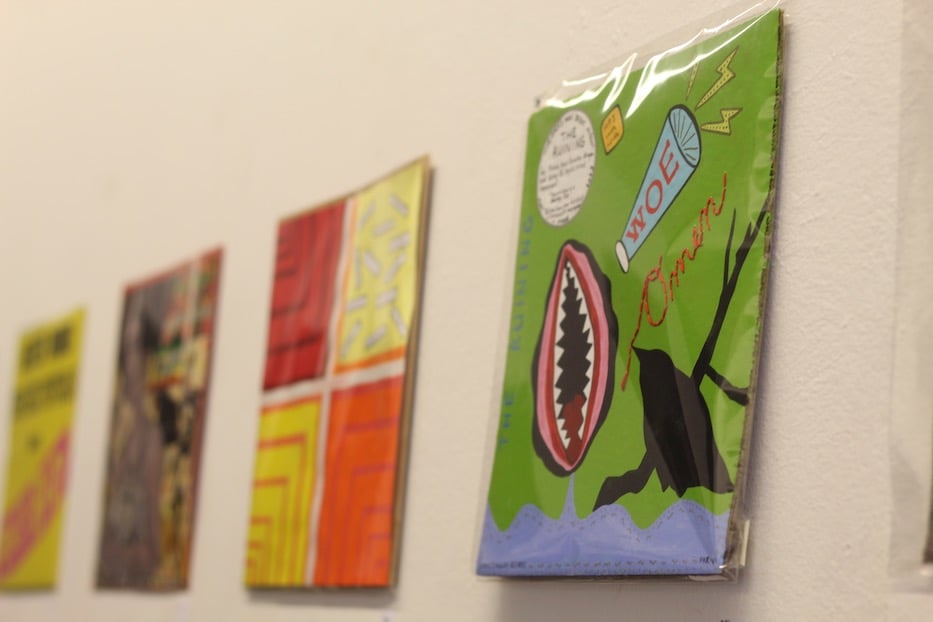
Woe Omen: The Ruining.
The exhibition feels full, but never like too much. On bookshelves and ledges around the room, Lewis has installed real-life album covers from WPKN’s copious archive, which jump from Big Mama Thornton to Barbra Streisand to Teresa Brewer. As she was receiving submissions, Lewis also folded in work and documents of of four women musicians: Cumming, a artist-activist who is in the band Sunflower Bean, beloved “Beehive Queen” Christine Ohlman, who has strong ties to Connecticut, Tina Weymouth of the Talking Heads and Tom Tom Club, and Eve Hars, whose career began to take off with Eva Haze, and then never really did.
Hars is now in the process of recording a real album, Charmed, while battling stage four breast cancer. Lewis, who originally received an email from her sister Ann after the deadline for artwork, said she was glad to include the history and amplify Hars’ work. “The story of trying to make it and not making it” is part of the story of women in music in this country, she said.
The inclusion of the four—paired with a few reimagined covers across the room—gives a viewer pause to think about the real adversities these four women have faced and the way their work has been at turns commodified (hello, Christine Ohlman Barbie) and celebrated. Beside images from Hars’ life and work, Cumming seems so alive. In one image, she interviews Rep. Alexandria Ocasio-Cortez. In another, taken at a protest, she smirks behind a pair of black shades and holds a sign reading “Anger Can Be Power!”
A handful of badges from her performances during the first years of the pandemic feel like a reminder that she is still here, still performing, still holding on to what she can. And a viewer wonders: why her? In what way are these two women, installed side-by-side, so different?
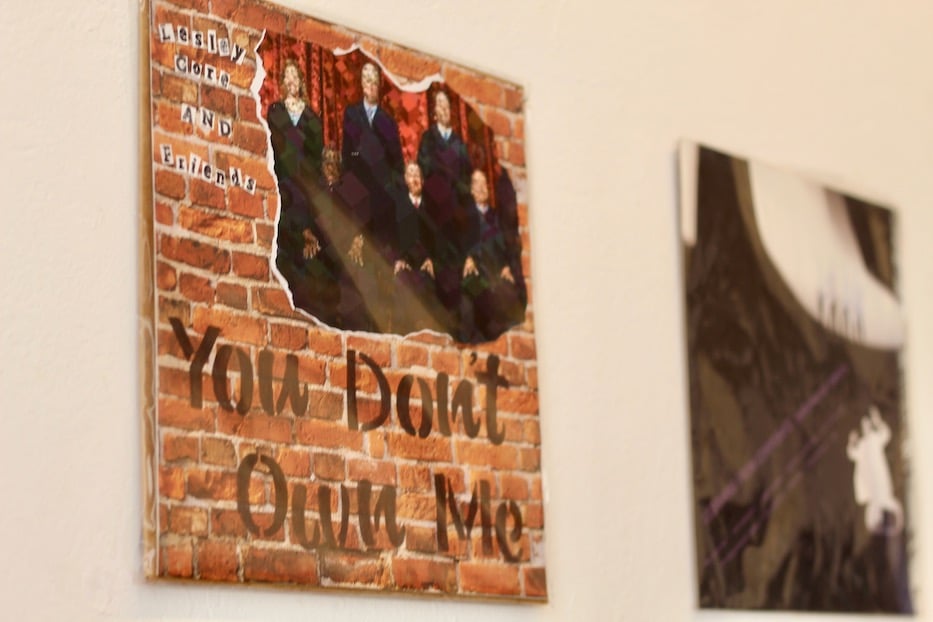
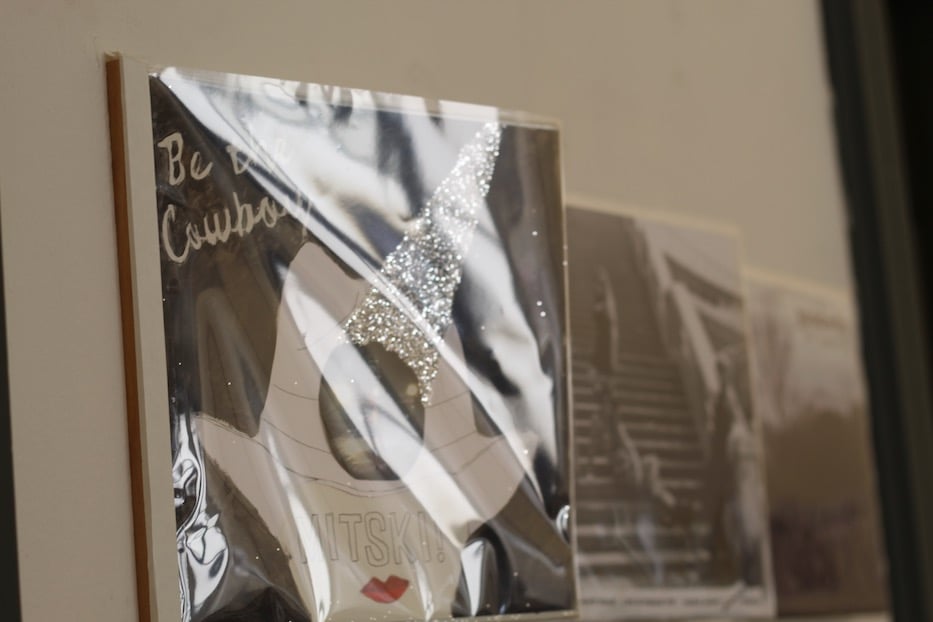
Top: Ann Kennedy’s take on Lesley Gore’s You Don’t Own Me. Bottom: Sadie Grey Murphy reimagines Mitski's Be The Cowboy.
It fits. This is a show meant to acknowledge the trauma of the past few years—and maybe of patriarchy itself—and find a way to laugh at and through it. Lewis, for instance, is a fierce advocate of reproductive freedom, and her own work has often sat at the intersection of identity, art making, history, existential dread, and social justice. But she’s not being flip or glib or escapist. She’s used humor as a coping mechanism for too long to discount its healing powers.
In this sense, she’s not the band, playing as the Titanic goes down; she’s the lifeboat. It’s a role she also wants the Institute Library to play—or to be able to play—as the city’s art scene moves through a period of transition.
Currently, both Artspace New Haven and Creative Arts Workshop are between directors (CAW has appointed an interim director), and the Ely Center of Contemporary Art is planning a number of open conversations after calls for a board member to step down earlier this year. She and artists are talking about an artist-organized open studios event at Erector Square, where her studio is based, in the fall.
“We need more [art, artists], not less, and having a scarcity mindset doesn’t help anyone,” Lewis said. “Art is really important. It’s how we communicate things that are difficult. And there’s something about being together, gathering—I want to make something where everybody can be together.”
“We need positive things that bring us together as artists,” she added. “I want people to feel like this place, this gallery, is for them.”
Sound & Vision II: For The Record runs in the Gallery Upstairs at the Institute Library through May 6. A closing party is planned for May 3 at 7 p.m. at Cafe Nine; tickets and more information are available here. The Institute Library is located at 847 Chapel St. in downtown New Haven.

